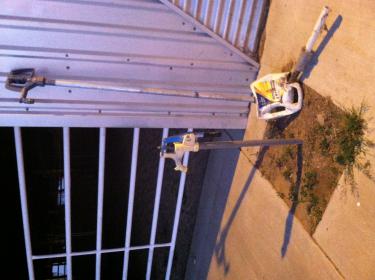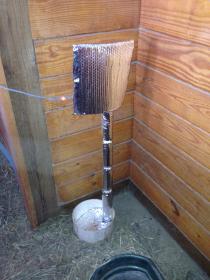I know many of us had this problem with last year’s extremely cold temps. Other than digging it out and putting it in deeper, has anyone come up with other ideas to prevent freezing? I prefer not having anything electric on overnight, so heating tape is out. I am thinking salt would be bad for the pipe. Any ideas?
We have over the years used a large pipe on the hydrants, filled with wadded up newspaper.
Some of those were fireplace square clay pipes we had left over.
You can also use a larger used car inner tube, cut it to size and fill it with wadded newspaper and folded over the handle.
You can fold it back to use it, then covered it again.
It depends on the faucet, where it is, how cold it gets, all they may take is a bit of help, or be so bad that nothing helps.
When mine have frozen, I have found that it is down deep, at the base, which is six feet down for us. Down where the plug is that lets the water through. We have found that this can be related to getting the area around the hydrant wet, and that water getting down that low, and getting cold enough to freeze down there, which freezes the hydrant. Takes quite a long time of warm weather to thaw it out too LOL! So my current plan is to avoid getting the area around the hydrant wet. I did have a plan to cover the ground around the hydrant with plastic, to direct any water away from the pipe underground, but somehow never got that done this summer. Duh. Currently hoping for a continued mild winter this year (which is a distinct possibility in this area, due to El Nino and something in the Pacific Ocean called “the blob”.)
Newly installed hydrants are the most likely to have problems with freezing, due to the dirt around them not being recompacted after the trench was dug to put it in. Another source of problems is traffic over the pipe, “drives the frost down deep”, evidently.
If it is buried deep enough, then the problem is most likely the drain is plugged at the bottom so the water stays in the pipe. Unfortunately the only solution is to dig it up, clean out the drain and then make sure the drain stays open and there is stone around it so the water can drain out.
When I installed mine last year I put the little drain tube inside a short piece of water line so it didn’t get kinked, put that in a piece of drain tile and surrounded all of it with gravel and stone, making sure all of that was below the frost line. It drains quickly and so far no problems with freezing.
[QUOTE=NancyM;8403470]
We have found that this can be related to getting the area around the hydrant wet, and that water getting down that low, and getting cold enough to freeze down there, which freezes the hydrant. [/QUOTE]
This makes sense. That’s why I was thinking of making a salt slurry and pouring it around the pipe before it got too cold. Then I thought maybe the salt would damage the pipe. Perhaps I can make a big hole in a muck bucket and put the head through that, so that the muck bucket keeps the ground around the pipe from getting wet. Or something like that.
PSA for those putting in hydrants:
When we put in a hydrant, we always use some kind of old plastic bottle at the bottom, to keep anything from getting in there and clogging the drain hole.
We also put some inches of gravel below that and around that so any water can drain easily:

If a hydrant does freeze, it can be safely and quickly thawed by pouring a little propylene glycol down it. Easily available at farm stores in the cattle section, sometimes called Keto-Aid. A few ounces and you’ll be good to go.
get some house insulation and wrap it. it helps. same with buckets if your horses won’t chew it off.
[QUOTE=NancyM;8403470]
We have found that this can be related to getting the area around the hydrant wet, and that water getting down that low, and getting cold enough to freeze down there, which freezes the hydrant.[/QUOTE]
I have good luck with leaving a short piece of hose attached to it, about three feet. It’s not so long that it affects the water draining back down, but it points the water where I want it to go without spilling. For me, that’s right into the Rubbermaid water tank. For a hydrant you’re using to fill buckets, etc. I’d leave a spare bucket underneath to catch any excess water.
The 2 common reasons hydrants freeze is water not draining and cold getting to the base. When you turn off a frost free hydrant the water in the vertical pipe drains to the bottom of the hydrant and out a drain hole. If the water does not have anywhere to go then water will stay in the vertical pipe and freeze. During installation some clean stone should be added at the base to help this. After installation there is not much you can do without digging. Each time you turn the hydrant off a pint of water drains down out of the pipe. If you limit the number of times you turn the hydrant off you will limit the amount of water that drains out.
The other problem is if your hydrant is not secure and wiggles then you are making a gap between the vertical pipe and the dirt. This gap will allow cold air down to the base and cause the water to freeze. It is also a good idea to have a small “volcano” of dirt around the hydrant. Then if the hydrant is outside you don’t have rain flowing down around the pipe into the ground.
Make sure you take your backflow preventer off if you have one on the hydrant. It will hold water in the hydrant pipe and not let it drain as designed.
I keep a push button start Propane torch to heat the pipe after disconnecting the hose when it’s really cold. If it’s installed so it drains quickly, a few quick swipes with the torch lets it all run down before it gets cold enough again to freeze the water in it. A drop or several may freeze on the threads, but the torch makes quick work of them when it’s time to re-attach the hose, as it does on the hose fitting.
I wrapped ours with the foil / bubble insulation with heat tape underneath. I also make a hood to go over the top. On the outside hydrants, the hood goes all the way to the ground. Outside hydrants also get a disc of same insulation on the ground at the base of the pipe.

